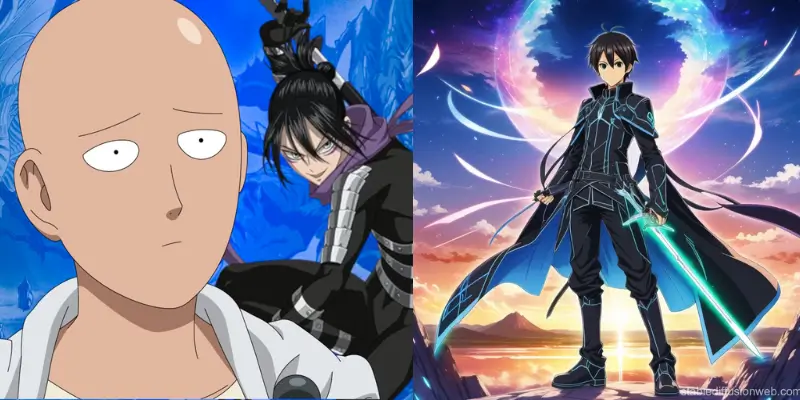In the colorful and immersive world of anime, fans use unique phrases to describe iconic tropes, memorable characters, and unexpected story twists. The phrase “anime:6tbztsekyf0= sus” has emerged from this cultural interplay as a fun, internet-inspired way to call out anime elements that feel suspicious, quirky, or unorthodox.
Originating from the “sus” slang in the game Among Us, where characters suspected of being impostors are labeled as “sus,” this term reflects anime fans’ love for humor, speculation, and engagement with the unexpected. Anime fans use “sus” not just to express skepticism but to engage with character motives, unexplained plot twists, and iconic tropes.
This slang phrase has carved out a unique space in anime culture, uniting fans through a shared, often humorous language. From Saitama in One Punch Man to Kirito in Sword Art Online, the “sus” factor now embodies a playful acknowledgment of the oddities that make anime beloved and intriguing.
What is “anime:6tbztsekyf0= sus”?
“Anime:6tbztsekyf0= sus” is more than just an internet phrase—it’s a way for fans to highlight the unexpected, eyebrow-raising moments in anime. It can refer to characters with questionable motives, bizarre plot devices, or even “too-perfect” portrayals of food and settings.
This term brings fans together to playfully scrutinize common anime tropes and to bond over the shared absurdities of their favorite shows. In anime communities, calling something “sus” provides a humorous and slightly critical angle, adding excitement to fan discussions.
This “sus” label reflects the fans’ imaginative interpretations and analysis, driving deeper engagement. Whether it’s the “beach episode” trope or gravity-defying hairstyles, the “sus” factor points out the quirks that make anime unique.

Origins and Rise of “Sus” in Internet and Anime Culture
The term “sus” shot to popularity with the release of the game Among Us in 2018, where players suspected of being impostors were labeled “sus” for suspicious behavior. This simple, two-syllable word quickly made its way across social media platforms, eventually seeping into other media cultures, including anime.
Fans soon started calling out characters, settings, and scenes that felt too convenient or exaggerated by calling them “sus.” As anime’s popularity grew globally, fans adapted this internet slang to apply to typical anime tropes, like overly powerful characters or unrealistic depictions.
Today, calling something “sus” in anime is a fun way to bond with other fans, fostering a sense of community and belonging through shared humor and insights.
Read Also: Rownavigator.com
Typical “Sus” Tropes in Anime
Anime thrives on unique storytelling and bold character designs, but certain repetitive tropes have become prime “sus” targets. For instance, anime is known for its exaggerated emotions, over-the-top battles, and romantic misunderstandings.
Fans often label these moments as “sus” to humorously question their practicality while still celebrating their creativity. From high school-centric plots to the infamous “power of friendship” narrative, these tropes have become markers of anime culture.
By calling them “sus,” fans keep the discussions lively and intriguing, adding a humorous twist to analyzing well-loved yet sometimes unrealistic storylines.
Overpowered Main Characters as “Sus” Elements
Overpowered characters, like Saitama from One Punch Man or Kirito from Sword Art Online, bring an undeniable “sus” factor to anime. These characters can defeat enemies effortlessly, sometimes making viewers question the stakes and challenges within the story.
While these characters captivate audiences with their strength, fans often find it amusing to wonder if they are “too powerful,” poking fun at the invincibility that seems “sus.” Characters like Tatsuya from The Irregular at Magic High School or Yugi from Yu-Gi-Oh! also embody the “sus” trope by showcasing unmatched abilities that make them nearly unbeatable.
This “sus” overpowered quality allows viewers to question the realism in anime’s exaggerated character portrayals while still admiring the flair and creativity that make anime a beloved medium.

The Role of Gravity-Defying Hairstyles in Anime
One of the most visually recognizable “sus” elements in anime is the characters’ gravity-defying hairstyles. From Naruto’s spiky locks to the vibrant colors of characters in Attack on Titan, anime hair breaks the laws of physics, adding a playful, surreal quality to the characters.
The unique hairstyles often symbolize a character’s personality, background, or powers, making them memorable to fans. Labeling these styles as “sus” is a light-hearted way to acknowledge the surrealism and creativity within anime while celebrating its freedom from reality’s constraints.
High School as a Constant Anime Setting
In the anime world, high school is one of the most common settings, appearing in countless series from various genres. While this setting provides relatable experiences and offers a coming-of-age narrative, the ubiquity of high school settings can also feel “sus.” The “sus” label humorously questions why so many supernatural battles, romances, and mysteries unfold within school corridors.
Despite this “sus” factor, fans appreciate how high school settings allow characters to explore universal themes of friendship, ambition, and identity. The familiar backdrop resonates with audiences, giving rise to relatable yet fantastical storytelling that keeps viewers hooked.
Food in Anime: Too Perfect to Be Real
Anime often portrays food in a way that feels too perfect, making viewers wonder if these dishes are “sus.” From exquisitely detailed sushi in Final Fantasy XV x Brotherhood to delectable ramen bowls in various series, anime’s food illustrations are mouthwatering and artistically crafted.
These idealized depictions of food celebrate culinary culture while showcasing the artistic talent of anime creators. Fans enjoy labeling these scenes as “sus” since they blur the line between animation and reality, leaving audiences in awe of anime’s visual allure.
The Mandatory “Beach Episode” and Its “Sus” Factor
The “beach episode” trope is a staple in many anime series, often used to provide lighthearted breaks in otherwise intense storylines. However, its predictable inclusion has earned it the “sus” label, as fans humorously question its necessity in so many shows.
Although the “beach episode” might seem like a convenient filler, it also allows characters to develop bonds and showcase personality quirks. By calling it “sus,” fans enjoy poking fun at this trope, finding humor in its consistency while still cherishing the light-hearted moments it brings.
Anime Plot Twists and Suspense: When “Sus” Comes Into Play
Anime is known for its unexpected plot twists that can leave viewers in shock or suspense. These twists often contain elements that seem “sus,” adding layers of intrigue and excitement to the story. The thrill of these surprises keeps fans invested, even if the twists feel contrived or overdramatic.
From cliffhangers to unexpected character reveals, anime plot twists create intense moments for fans to dissect. The “sus” label allows fans to engage playfully with these shocking moments, encouraging discussions about character motives and potential theories.
Impact of Internet Slang on Anime Fandom
Internet slang, such as “sus,” has become an integral part of anime discussions, connecting fans across the globe. This slang creates an inclusive language that enhances fan engagement, bringing in humor, relatability, and mutual understanding among anime lovers.
The use of “sus” and other internet slang terms allows fans to express themselves creatively, building a stronger, more interactive fandom culture. These terms bridge anime with global internet trends, enriching fan discussions with relatable, modern language.
Social Media’s Role in Spreading Anime Humor and “Sus” Terms
Social media platforms like Twitter and Reddit have played a significant role in spreading anime humor, memes, and terms like “sus.” Through fan discussions, meme culture, and trending topics, social media connects fans worldwide, creating a shared space for playful critique and appreciation of anime.
These platforms encourage fans to participate in discourse, express opinions, and bond over favorite series, scenes, or characters. Social media has transformed anime fandoms into thriving, interactive communities that celebrate anime culture in all its uniqueness.
How “Sus” Strengthens Community Engagement Among Fans
The use of “sus” in anime discussions has fostered a sense of community among fans, who enjoy sharing inside jokes and calling out humorous elements together. This shared language enhances the sense of belonging and allows fans to bond over their favorite shows in a lighthearted way.
By calling characters, scenes, or plot twists “sus,” fans create an inclusive community atmosphere. This approach strengthens fan engagement, as it turns anime into a shared experience rather than just a solitary pastime.

The Future of Anime, Gaming, and Online Humor
As anime and internet culture continue to evolve, the fusion of humor, gaming slang, and anime appreciation will likely grow stronger. The popularity of terms like “sus” hints at a future where anime and gaming fandoms are closely intertwined, influencing one another with shared language and humor.
Collaborations like Fortnite anime crossovers highlight the growing connections between gaming and anime. These crossovers signify a future where gaming and anime trends converge, creating even richer experiences for fans.
Read Also: Eva Marcille Twin Sister
Quick Facts
- The term “sus” originates from the internet game Among Us, where players use the word to describe others who might be lying or acting suspiciously.
- In anime, “sus” is often applied to characters, moments, or plot developments that seem untrustworthy, strange, or out of place, contributing to meme culture.
- Anime has become a rich source of internet slang, and terms like “sus” have helped fuel fan discourse and anime meme culture online.
- Many iconic anime characters like Saitama from One Punch Man and Kirito from Sword Art Online have become “sus” figures, often through their overpowered traits.
- Internet slang and anime memes heavily influence one another, contributing to the viral nature of terms like “sus” across social platforms.
Final Thoughts
The term anime:6tbztsekyf0= sus and its application in anime reflects how internet culture continuously merges with fandoms, making content more interactive and participatory. It shows how anime tropes and anime meme culture are evolving, driven by community humor and online trends.
These elements not only keep the anime world fresh and engaging but also help build a unique, interconnected global fandom that thrives on social media and fan interactions. Whether it’s through over-the-top characters or unexpected plot twists, “sus” encapsulates the unpredictable nature of anime and the fun ways fans connect over their favorite moments.
As anime continues to evolve, it will undoubtedly keep surprising us with its quirky trends and captivating narratives. The “sus” phenomenon is just one example of how anime can reflect and amplify online humor, ensuring that the fandom remains vibrant and alive.
FAQs
What does “sus” mean in anime?
“Sus” is short for “suspicious,” and in anime, it describes anything—be it a character, a plot twist, or a moment—that seems odd, misleading, or untrustworthy. It originates from the game Among Us, but has been embraced by the anime community as part of internet slang.
How has “sus” influenced anime culture?
The term has become a part of anime meme culture, allowing fans to joke about characters or situations that feel “off.” It adds another layer of interaction, with fans using it to critique or highlight moments in anime that challenge expectations.
Why do anime characters like Saitama or Kirito become “sus”?
Characters like Saitama from One Punch Man and Kirito from Sword Art Online are often deemed “sus” due to their overwhelming powers or behavior, which can make them seem too perfect or oddly out of place, leading to suspicion among fans.
What role does social media play in spreading anime slang like “sus”?
Social media platforms, especially Twitter and TikTok, help spread and popularize terms like “sus” through memes, fan art, and videos. These platforms allow fans to share their thoughts quickly and connect with others over common references in anime.

